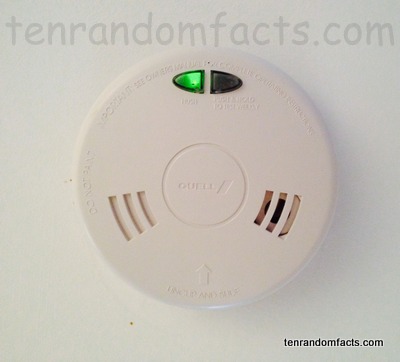Have you checked your smoke detector for working batteries recently?
- Smoke detectors are an invention used to detect smoke, and particularly to warn of the danger of a fire, and in 2013, approximately 93% of households in the United States had the device in their home.
- There are three main types of smoke detectors used to sense fire dangers, including those that use photoelectric or optical sensing; ionisation which uses radioactive elements; and air sampling known as ‘aspirating’ detectors or ASD.
- Smoke detectors sometimes have a mix of two types of sensors – photoelectric and ionisation – as different sensors perform better during different stages of a fire, with the former being best during smouldering stages, and the latter during flaming stages.
- Smoke detectors are often installed in both commercial and domestic buildings; and they are usually found in the centre of a ceiling, in hallways, on each building level, as well as in or near sleeping quarters.
- Approximately 30% of smoke detectors in households will fail to function during an actual fire danger, primarily due to the detector malfunctioning because of age, battery removals and dead batteries.
- The size of a common disc-shaped smoke detector is usually around 15 centimetres (6 inches) in diameter and 2.5 centimetres (1 inch) deep, and they are generally encased in a plastic, cylindrical cover.
- Americans Francis Upton, an acquaintance of Thomas Edison, and Fernando Dibble are widely recognised as the inventors of the first portable electric fire alarm, an early smoke detector which was patented in 1890, although other fire alarms were in existence at the time.
- A heat-based detector was invented in 1902 by George Andrew Darby from England, while the birth of the ionised smoke detector occurred during the 1930s, and was accidentally discovered by Walter Jaeger, from Switzerland, after his unsuccessful gas detector reacted to cigarette smoke.
- After decades of development, domestic smoke detectors became more readily available and more affordable in the 1970s, while a number of countries now have laws that require the device in all public buildings and private dwellings.
- Smoke detectors primarily alert through noise, often around 85 decibels with a piercing alarm sound, although voice, lights, and futuristic ideas like vibrations can also be utilised.
Bibliography:
Types of Smoke Alarms, 2015, Department of Fire & Emergency Services, http://www.dfes.wa.gov.au/safetyinformation/fire/fireinthehome/Pages/typesofsmokealarms.aspx
Smoke Detector, 2015, Wikipedia, https://en.wikipedia.org/wiki/Smoke_detector







